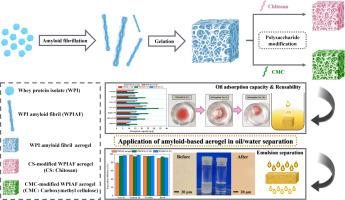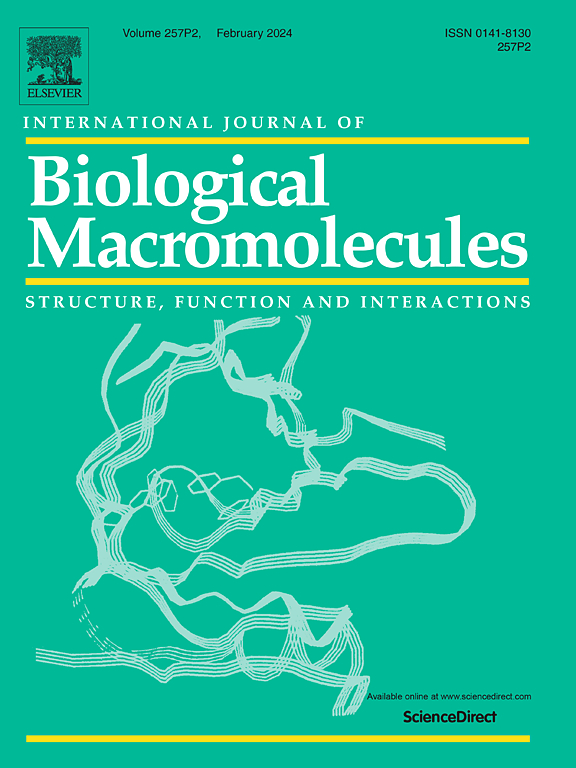Applications of three-dimensional whey protein amyloid fibril-based hybrid aerogels in oil/water separation and emulsion separation
IF 7.7
1区 化学
Q1 BIOCHEMISTRY & MOLECULAR BIOLOGY
International Journal of Biological Macromolecules
Pub Date : 2024-12-01
DOI:10.1016/j.ijbiomac.2024.137680
引用次数: 0
Abstract
Environmental contamination from oil spills and industrial wastewater poses long-term risks to ecosystems and human health. Amyloid fibrils' superior stiffness and stability, outstanding biocompatibility and biodegradability, versatile functional groups, and high specific surface area make them promising sustainable adsorbents. This study is aimed at examining the application of three-dimensional polysaccharide-modified whey protein amyloid fibril (WPIAF) aerogels in oil/water separation and emulsion separation. The WPIAF aerogel was first synthesized through the salting out method coupled with lyophilization, then modified using carboxymethyl cellulose (CMC) or chitosan (CS). Our results showed that WPIAF aerogels exhibited increased mechanical properties and surface hydrophobicity after polysaccharide modification. The CS-modified WPIAF aerogels showed better oil adsorption capacities, oil adsorption capability, and reusability than WPIAF aerogel and CMC-modified WPIAF aerogels. Furthermore, the applicability of polysaccharide-modified WPIAF aerogels in a continuous oil/water separation system was demonstrated. Finally, the separation efficiencies of polysaccharide-modified WPIAF aerogels were determined to be over 90 % in various emulsion systems, and the possible separation mechanism was further investigated. This study provides a nice example of applying amyloid-based aerogels for oil/water separation and emulsion separation.

基于三维乳清蛋白淀粉样纤维的混合气凝胶在油/水分离和乳液分离中的应用。
石油泄漏和工业废水造成的环境污染对生态系统和人类健康构成长期风险。淀粉样蛋白纤维具有优异的硬度和稳定性、出色的生物相容性和生物可降解性、多种功能基团和高比表面积,使其成为前景广阔的可持续吸附剂。本研究旨在探讨三维多糖修饰的乳清蛋白淀粉样纤维(WPIAF)气凝胶在油/水分离和乳液分离中的应用。首先通过盐析法和冻干法合成 WPIAF 气凝胶,然后使用羧甲基纤维素(CMC)或壳聚糖(CS)对其进行改性。结果表明,多糖改性后的 WPIAF 气凝胶具有更高的机械性能和表面疏水性。与 WPIAF 气凝胶和 CMC 改性的 WPIAF 气凝胶相比,CS 改性的 WPIAF 气凝胶在吸油量、吸油能力和可重复使用性方面表现更佳。此外,还证明了多糖改性 WPIAF 气凝胶在连续油/水分离系统中的适用性。最后,确定了多糖改性的 WPIAF 气凝胶在各种乳液体系中的分离效率超过 90%,并进一步研究了可能的分离机理。这项研究为将淀粉基气凝胶应用于油/水分离和乳液分离提供了一个很好的范例。
本文章由计算机程序翻译,如有差异,请以英文原文为准。
求助全文
约1分钟内获得全文
求助全文
来源期刊
CiteScore
13.70
自引率
9.80%
发文量
2728
审稿时长
64 days
期刊介绍:
The International Journal of Biological Macromolecules is a well-established international journal dedicated to research on the chemical and biological aspects of natural macromolecules. Focusing on proteins, macromolecular carbohydrates, glycoproteins, proteoglycans, lignins, biological poly-acids, and nucleic acids, the journal presents the latest findings in molecular structure, properties, biological activities, interactions, modifications, and functional properties. Papers must offer new and novel insights, encompassing related model systems, structural conformational studies, theoretical developments, and analytical techniques. Each paper is required to primarily focus on at least one named biological macromolecule, reflected in the title, abstract, and text.

 求助内容:
求助内容: 应助结果提醒方式:
应助结果提醒方式:


